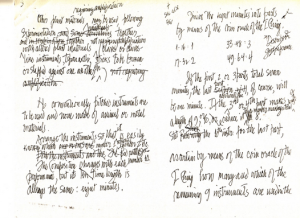Child of Tree by John Cage
John Cage, one of the most impactful composers of the twentieth century, wrote Child of Tree in 1975, an improvisatory solo for “found percussion.” “In late 1950, Cage was given a copy of the I Ching, the ancient Chinese oracle text in which images are selected at random from a set of 64 by means of tossing yarrow sticks or coins” This gave Cage the idea of basing the works’ performance on a “coin-tossing oracle as a way of selecting the sonorities from his own charts.”
Found percussion are instruments that are discovered by performers in nature or pre-made non-percussion objects such as water or car parts. This adds an aleatoric aspect to the timbre of pieces written for found percussion. In Child of the Tree John Cage dictates that the found percussion instruments used be various types of plants. For example, the instrumentation calls for a cactus and a tree branch. In the video performance I found there were also pinecones, stones, and what looked like large acorns used as percussion instruments as well.
As far as the timbral effects of the instrumentation, just the fact that the instruments are found percussion give an aleatoric feature that is unique even among experimental instruments. Looking at the cactus alone, the instrument is plucked, bowed, tapped, poked, struck, rolled, and vibrated with a tremolo-like effect. Each of the other various plants mentioned above are played with the same number of techniques that give them an even greater variety of timbre than the long list above indicates.
This work has been performed that a graduate student at a Florida State University Percussion Ensemble concert of the works of John Cage. Their selection of this piece for their repertoire speaks to its importance in John Cage’s body of work.
Even though the new notation is not normally required for found percussion because they can be played in a typical way, John Cage chose to use a timeline-and-text notation to dictate the guidelines for the performance of Child of Tree. This notation style leaves the performer a wide artistic license so they can have a very creative improvisation. Despite this, Cage still supplies extraordinarily specific directions to give narrower guidelines to the improvisation. This balance between the control of specific aspects of the composition yet no control of the performers’ choices or the chance of the I Ching give this piece a unique timbre and form. The use of new instruments increases the level of novelty for both the listener and performer. The manuscript consists of several pages of hand-written instructions and details about how to operate the I Ching dice game and which elements of the composition were up to chance.
For John Cage’s purposes of this composition, there are no limitations to the use of new, experimental instruments. Because this piece is written from the perspective of timeline-and-text notation, unconventional percussion techniques, and the element of chance, the use of found percussion lends itself well to the obscurity of the performance of this work. Found percussion of the plant variety would be more limited in a work that required the rhythmic accuracy of conventional notation. Overall, John Cage’s compositional techniques eradicate the typical limitations of these instruments and this provides a good example of a well-executed usage of found percussion as an experimental instrument.

Manuscript Edition of Child of Tree is pictured above.
Works Cited
James Pritchett, et al. “Cage, John.” Grove Music Online. Oxford Music Online. Oxford University Press, accessed April 7, 2015, http://www.oxfordmusiconline.com.proxy.lib.fsu.edu/subscriber/article/grove/music/A2223954.
Leave a comment